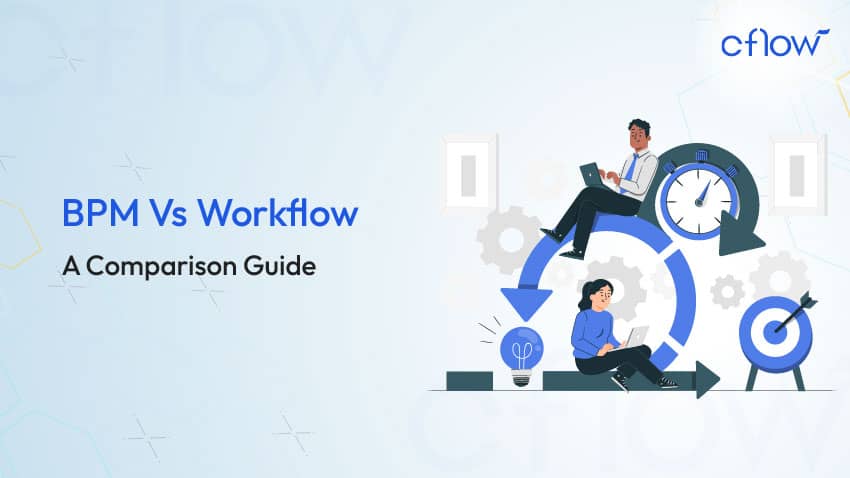BPM Vs Workflow: Are They the Same?

Key Takeaways
Workflow management focuses on executing individual tasks efficiently through automation, role assignment, and sequential routing—ideal for department-level processes like content approvals or onboarding.
Business Process Management (BPM) provides a strategic, organisation-wide approach that models, monitors, and optimises multiple interconnected workflows to improve enterprise performance.
BPM offers advanced capabilities such as data analysis, real-time dashboards, and process orchestration across departments, enabling continuous improvement and strategic alignment with business goals.
Workflow tools are quick to deploy and ideal for solving localised challenges, while BPM platforms support cross-functional collaboration, scalability, and agile decision-making at scale.
Cflow’s no-code BPM platform combines the simplicity of workflow automation with the depth of BPM, allowing business users to build, customise, and optimise processes without technical expertise.
Real-world results include a 65% reduction in supply chain response time using BPM and a 40% faster content publishing cycle through structured workflow management, demonstrating tangible ROI for both approaches.
BPM Vs Workflow – A Comparison Guide
BPM stands for Business Process Management, and Workflow Management is a straightforward word that refers to the flow of work from one person to another or one phase to another. So, where did this confusion emerge from?
What is Workflow Management?
Workflow management focuses on the execution of a sequence of tasks to complete a specific activity. It defines who does what, when, and how — often using automation to streamline the process.
Key Characteristics:
Task-Oriented: Manages discrete, repeatable activities (e.g., onboarding a new hire).
Automation-focused: Reduces manual handoffs and errors.
Role-Specific: Assigns responsibilities to specific users or systems.
Quick Deployment: Often implemented at the department level.
Example: A content publishing workflow involving a writer, editor, and approver is a classic example. Each person performs their role in sequence until the article is live.
What is Business Process Management (BPM)?
BPM is a strategic discipline that involves modelling, monitoring, analysing, and optimising end-to-end business processes. It spans departments, systems, and stakeholders to improve overall business performance.
Key Characteristics:
Process-Oriented: Focuses on managing entire business operations.
Holistic: Encompasses multiple workflows across systems and departments.
Analytical: Uses data for continuous improvement and optimisation.
Strategic Alignment: Ensures processes support organisational goals.
Example: Launching a new software product involves engineering, marketing, sales, and support teams. BPM coordinates these departments into a seamless process.
| Feature | Workflow Management | Business Process Management (BPM) |
|---|---|---|
| Scope | Single task or process | Organization-wide processes |
| Focus | Task execution | End-to-end process optimization |
| Users | Team-level roles | Cross-functional teams |
| Tools | Automation of forms and task sequences | Integrated dashboards, analytics, reporting |
| Goal | Complete a task efficiently | Improve overall process performance |
| Implementation | Fast and simple | Longer, strategic implementation |
Analogy: If a workflow is how a plane lands — a sequence of tasks performed by the pilot, tower, and crew — then BPM is the entire airport operation, managing landings, takeoffs, refuelling, and maintenance together.
Real-World Examples
Automotive Supply Chain Management (BPM in Action)
Context:
An international automobile manufacturer was at risk of halting production due to a global semiconductor shortage. This posed a significant threat to its bottom line, potentially costing millions in delayed shipments and contract penalties.
Problem:
Supplier updates were being buried in overflowing inboxes. Critical information—such as shipment delays or volume changes—was often missed or reacted to too late. While the symptoms appeared isolated (i.e., email mismanagement), the root causes were embedded across multiple departments and systems.
BPM Approach:
Rather than fixing the email issue in isolation, the company applied a Business Process Management (BPM) strategy to map and redesign the entire semiconductor sourcing process. They used a low-code BPM platform to:
Extract data automatically from supplier emails using AI.
Use Robotic Process Automation (RPA) to enter supplier data into the vendor management system.
Set threshold-based alerts that notify procurement teams of critical deviations.
Display supply status via a real-time dashboard, colour-coded for quick issue identification.
Results:
A 65% reduction in response time to supply chain disruptions.
Improved cross-departmental visibility into risks.
The ability to adapt workflows dynamically as new risks emerge, without weeks of redevelopment.
Key Takeaway: BPM empowered the organization to orchestrate multiple systems and teams, reducing silos and enabling agile decision-making during a crisis.
Editorial Content Approval Workflow (Workflow Management in Action)
Context:
A growing digital publishing company needed a more efficient way to handle content reviews for blog posts, whitepapers, and press releases.
Problem:
Articles were getting lost in inboxes, feedback cycles were inconsistent, and delays were frequent due to a lack of process visibility. The content team wanted a structured yet flexible process without involving IT for every change.
Workflow Solution:
Using a workflow automation platform, they implemented a content review process that involved:
Sequential routing of articles from the writer → editor → subject matter expert, → legal team.
Deadline-based triggers that reminded users when reviews were pending.
Integrated status tracking through their Web Content Management System (WCMS).
Audit trails to ensure compliance with regulated content.
Results:
40% faster publishing cycle.
Reduced errors and redundant feedback loops.
Full visibility for all stakeholders into content status at any stage.
Key Takeaway: Workflow management helped a single department eliminate bottlenecks and improve accountability, without the complexity of enterprise-wide process changes.
What Should You Choose? BPM or Workflow Software
Without a doubt, go for a complete BPM software like Cflow because it includes lots of useful features and is much bigger than a simple workflow software that may have limited features. Besides, all business process management programs do have the ability to create workflows and streamline them to improve productivity.
Cflow is a business process management software that follows the no-code method and can be used by any manager or employee without coding skills. The visual workflows are easier to understand and simplify your daily work while contributing to business efficiency.
What would you like to do next?
Automate your workflows with our Cflow experts.

